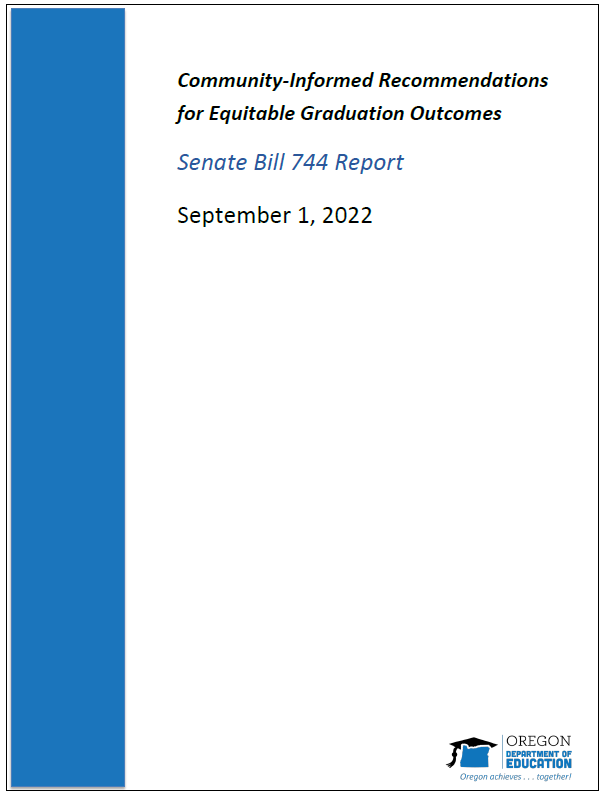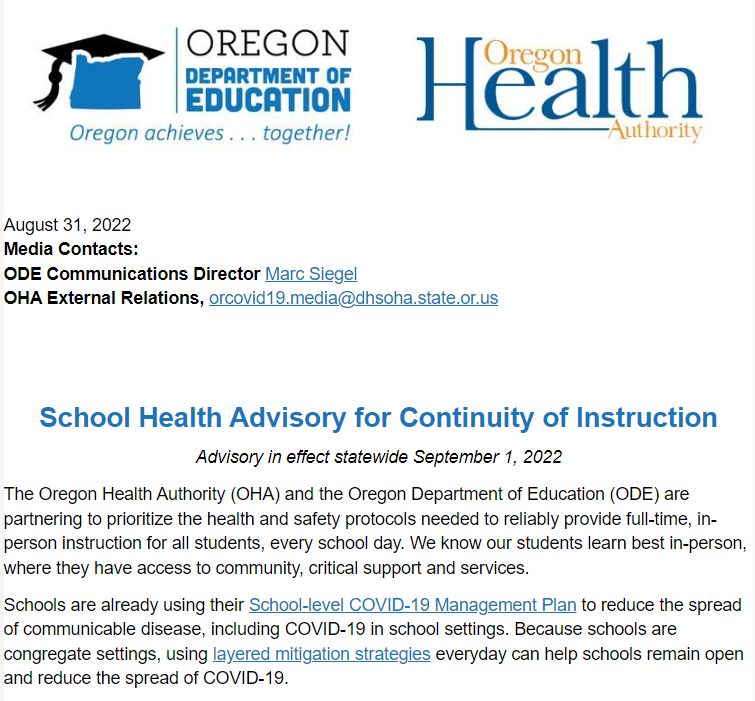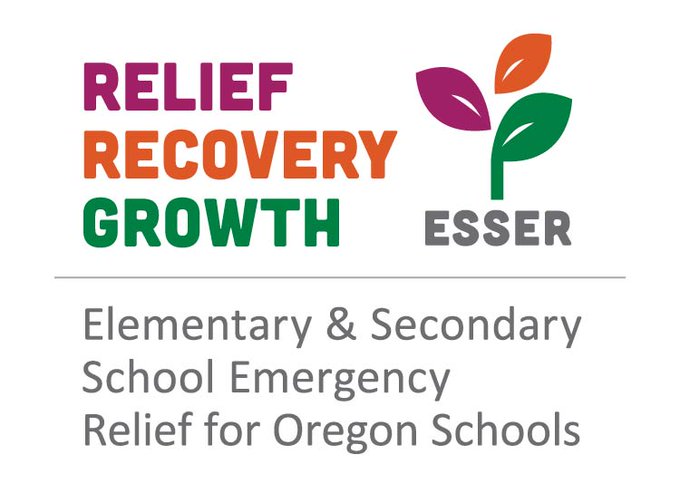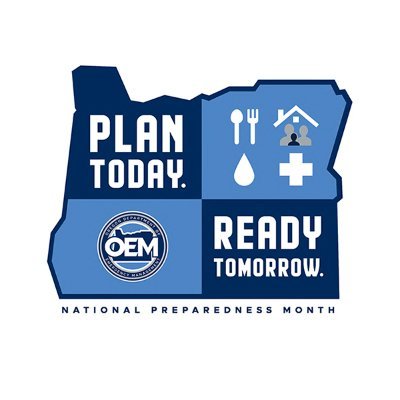ODE Releases Recommendations Report On Making Oregon’s Diploma Requirements More Equitable, Accessible and Inclusive
 Following an extensive community engagement process, the Oregon Department of Education has released a report to the Oregon Legislature and State Board of Education titled, “Community-Informed Recommendations for Equitable Graduation Outcomes: Senate Bill 744 Report.”
Following an extensive community engagement process, the Oregon Department of Education has released a report to the Oregon Legislature and State Board of Education titled, “Community-Informed Recommendations for Equitable Graduation Outcomes: Senate Bill 744 Report.”
The report, developed in response to legislative request, contains a summary of the department’s engagement process and feedback, a review of current Oregon diploma requirements, a review of graduation data and essential skills, a scan of nationwide diploma requirements and trends, and determinations and recommendations for the Oregon Legislature and State Board of Education to consider and inform future graduation policy decisions. Oregon’s graduation requirements were last reviewed in 2007 and updated in 2008 and phased in through 2013.
Oregon retains stringent requirements for teaching and assessment of reading, writing, math and all other content areas within high school courses, as the number of high school credits required has not changed and remains as rigorous as any in the nation. To earn a diploma in Oregon, students must earn passing grades in 24 high school credits, including four years of language arts and three years of math. Oregon’s high school diploma credit requirements are among the most demanding in the country; at present, no state requires more credits to graduate (Education Commission of the States, 2019).
Statewide Engagement
To develop the recommendations, ODE coordinated extensive statewide engagement, involving more than 3,500 diverse students, community members, families, educators, and representatives of higher education and workforce and industry. ODE also conducted an in-depth review of Oregon graduation data by investigating inequities and disparities, exploring diploma policies in other states and comparing Oregon diploma policies with national trends.
Statewide, local, and regional engagement was hosted by both ODE and Oregon’s Kitchen Table to gather feedback from a diverse variety of community members. Participants were asked what they value in education and what a diploma means to them, their family, and their community.
“Oregon is fortunate to have so many diverse community members from throughout the state deeply committed to informing future graduation policies,” said Colt Gill, Director of Oregon Department of Education. “Their contributions enabled the Oregon Department of Education to perform a deep, equity-based review of diploma policies to help prepare Oregon’s students for a productive and opportunity-filled future. Thank you to everyone who participated in this necessary review.”
Determinations and Principles
The report includes two determinations in response to questions posed by SB 744, which ODE was entrusted with addressing. The report does not recommend changing diploma requirements in basic academic skills. Determination #1 addresses the question, “of whether the skills and knowledge expected to be attained by persons who earn high school diplomas in this state… align with the requirements for high school diplomas in this state.” Determination #2 addresses the question, “of whether the requirements for high school diplomas in this state have been applied inequitably to different student populations.”
Determination 1: ODE has determined that the skills and knowledge expected by business, industry, and postsecondary education do not fully align with the current requirements for the Oregon Diploma.
Determination 2: ODE has determined that the requirements for Oregon high school diplomas have been applied inequitably to different student populations. ODE developed final recommendations (which can be found in the report) by following the principles listed below when synthesizing the information gathered from the review and engagement process:
-
Center accountability on systems, not students. Place accountability on systems to provide the educational resources needed to make requirements feasible for students.
-
Reflect student and community assets. Equity in graduation requirements demands that Oregon's diploma process honors and recognizes student, family and community diversity, culture, assets and strengths (especially communities who have been historically marginalized such as those experiencing poverty, those experiencing housing instability, those experiencing disabilities, those experiencing mobility, those who are multilingual, and students who identify as Black/African-American, Indigenous or Native, LGBTQ2SIA+ community members.)
-
Prepare students for their futures. Diploma requirements must be designed so students are prepared to thrive in the ever complex and changing world after graduation.
-
Create coherence and clarity. Diploma requirements should be accessible, with clear expectations and steps to achieving a diploma identified.
These recommendations are intended to make Oregon’s diploma requirements more equitable, accessible, and inclusive for all students. The recommendations do not stand alone and should not be implemented independently. If the State Board of Education and/or Legislature consider implementation of any of the recommendations they should be implemented in a coordinated fashion that is further informed by active and robust community engagement.
The final report and supporting appendices can be accessed online. The process and report offer an opportunity for the Legislature and State Board of Education to review Oregon’s diploma requirements and consider updates to better serve all of our youth. This report shows that Oregon has a chance to reimagine and rebuild our education system in a way that more equitably serves Oregon’s students. This report in and of itself does not direct any action on Oregon’s diploma requirements, any action based on these requirements would be signaled by future direction from the Oregon Legislature or State Board of Education. Any questions and comments can be directed to:
ODE.SenateBill744@ode.oregon.gov.
School Health Advisory for Continuity of Instruction
 The Oregon Health Authority (OHA) and the Oregon Department of Education (ODE) are partnering to prioritize the health and safety protocols needed to reliably provide full-time, in-person instruction for all students, every school day. We know our students learn best in-person, where they have access to community, critical support and services.
The Oregon Health Authority (OHA) and the Oregon Department of Education (ODE) are partnering to prioritize the health and safety protocols needed to reliably provide full-time, in-person instruction for all students, every school day. We know our students learn best in-person, where they have access to community, critical support and services.
Schools are already using their
School-level COVID-19 Management Plan to reduce the spread of communicable disease, including COVID-19 in school settings. Because schools are congregate settings,
using layered mitigation strategies every day can help schools remain open and reduce the spread of COVID-19.
ODE and OHA last issued a School Health Advisory on May 13, 2022. That advisory was in effect until August 31, 2022. This advisory is in direct response to the start of the 2022–23 school year and names actions that schools and families can take to reduce the spread of communicable disease throughout the year.
This School Health Advisory does not have an expiration date. A new school health advisory may be issued or this advisory may be rescinded in response to increased risk or reduced risk in Oregon.
You can read the full advisory online.
SEL Advisory Group Members Wanted
 The Oregon Department of Education (ODE) is seeking participants that reflect the diversity of the public K-12 student population for its K-12 Social Emotional Learning (SEL) Framework & Standards Advisory Group. This group will work with ODE to develop a K-12 SEL Framework and Standards for Oregon to be adopted by the State Board of Education by September 2023. The adopted SEL Framework and Standards will be implemented in Oregon schools starting in the fall of 2024.
The Oregon Department of Education (ODE) is seeking participants that reflect the diversity of the public K-12 student population for its K-12 Social Emotional Learning (SEL) Framework & Standards Advisory Group. This group will work with ODE to develop a K-12 SEL Framework and Standards for Oregon to be adopted by the State Board of Education by September 2023. The adopted SEL Framework and Standards will be implemented in Oregon schools starting in the fall of 2024.
APPLY NOW (Application window closes on September 18th at 11:59 p.m.)
This Advisory Group will be guided by
ODE’s Equity Stance,
ODE’s Integrated Model of Mental Health and the beliefs and values articulated in the
“Whereas” statements of HB 2166 as we develop Oregon’s K-12 SEL Framework and Standards. We will build from the Phase 1 HB 2166 SEL Advisory Group’s initial recommendations that will be shared with the State Board of Education on September 22, 2022.
Who is eligible to serve on the Advisory Group?
Current building educators and practitioners who have experience with integrating SEL across content areas, grade-levels, and throughout various contexts in the school day. ODE will prioritize participant selection based on educator and regional diversity, educational experience and professional learning, active classroom educators, instructional coaches, and teachers on special assignment.
How will each group member contribute?
Advisory members will commit to participating in regular meetings from October 2022 through June 2023. Every group member will bring important contributions in the following ways:
- Develop, in collaboration with other Advisory Group members, a Social Emotional Learning Framework and K-12 Social Emotional Learning Standards that build on the recommendations of the HB 2166 Advisory Group.
- Ensure culturally responsive and anti-oppressive approaches are at the center of the SEL framework and standards.
- Advocate through the lens of racial equity, trauma-informed principles and practices, and strengths-based models.
- Attend all required virtual
K-12 SEL Framework & Standards Advisory Group Meetings.
- Complete individual review and research of materials and resources.
- Provide support for implementation guidance by identifying and sharing best and promising practices, materials, resources and professional learning.
What is the commitment?
We are seeking a nine-month commitment from selected participants from October 14, 2022 through June 8, 2023. Virtual meetings will be held monthly on the second Thursday for three hours either in the mornings (9:00 a.m. - 12:00 p.m.) or afternoons (1:00 - 4:00 p.m.). We will also be organizing into various smaller workgroups to develop the SEL Framework and Standards which may require an additional 1 hour of synchronous/asynchronous work to be determined by the smaller work groups. The total time commitment for this role will be approximately 3-4 hours each month. Selected participants are expected to attend all
K-12 SEL Framework & Standards Advisory Group Meetings, so please place a hold on your calendars for the dates and times. ODE will reimburse districts for a half-day substitute, therefore each participant will need to get supervisor approval.
To apply, please
complete the SEL Framework & Standards Advisory Group Application by 11:59 PM on Sunday, September 18, 2022.
On October 3rd, we will notify applicants that they have been selected to serve on the Advisory Group and provide more information regarding our Advisory Group launch meeting on October 14th from 9:00 a.m. - 12:00 p.m.
Note: If you are an educator or practitioner, you will need your administrator’s approval to apply.
For more information on
ODE’s SEL Framework and Standards work, if you have any difficulty accessing the application link, need the application to be in a different language or format, or if you have any questions, please reach out to ODE’s SEL Specialist at
Vanessa.martinez@ode.oregon.gov.
ESSER Expenditure Transparency Dashboard Now Online
 The Oregon Department of Education is pleased to announce the launch of the Elementary and Secondary School Emergency Relief (ESSER) Funds Expenditure Transparency Dashboard.
The Oregon Department of Education is pleased to announce the launch of the Elementary and Secondary School Emergency Relief (ESSER) Funds Expenditure Transparency Dashboard.
As with any significant investment in public education, our community partners have an interest in learning about how school districts and the state are utilizing ESSER funds to best serve students, educators, and communities. To enhance transparency, ODE has created a publicly accessible ESSER Expenditure Dashboard. The dashboard shows the district reimbursement requests that ODE has processed for all three rounds of ESSER funding.
Note that the dashboard does not immediately reflect actual district and ESD expenditures, but rather, requests for and the ODE processing of reimbursement requests. Districts and ESDs may request reimbursements at any time and many make requests monthly, quarterly, or on some other schedule. Therefore, the dashboard will accurately reflect reimbursements made by ODE, but may not accurately reflect expenditures in real time at the district level.
As ODE processes district reimbursement requests for ESSER funds, the ESSER Expenditure Dashboard will continue to be updated to assist the public in understanding when and how the funds are being spent.
To access the dashboard,
please visit the ODE ESSER Transparency webpage.
The Elementary and Secondary School Emergency Relief funds are awarded to Oregon through three separate federal acts in response to the COVID-19 pandemic:
- Coronavirus Aid, Relief, and Economic Security Act in March 2020 (ESSER I)
- Coronavirus Response and Relief Supplemental Appropriations Act in December 2020 (ESSER II)
- American Rescue Plan in March 2021 (ESSER III)
The ESSER funds provide Oregon school districts and the Oregon Department of Education the opportunity to respond to the unique needs of each district and expand efforts already underway, such as:
- Addressing unfinished learning through asset-based acceleration strategies;
- Prioritizing health, safety, wellness, and connections for all communities;
- Increasing access to culturally responsive mental and social/emotional wellbeing supports; and
- Strengthening high-quality, culturally sustaining and revitalizing instruction, leadership, and pathways to graduation and post-secondary transitions.
For more information, please visit
ODE’s Federal COVID-19 Stimulus Resources page.
If you have any questions or need more information, please contact the ODE ESSER team at
ode.esser@ode.oregon.gov.
September is National Preparedness Month
 Story provided by the Oregon Department of Emergency Management
Story provided by the Oregon Department of Emergency Management
For families, September is all about back to school, but it’s also National Preparedness Month, a great time to talk with kids and teens about how to prepare for an emergency or disaster.
Emergencies and disasters can occur anywhere, anytime. Everyone in your household - especially kids – needs to know what to do when they happen. Talking about this can be scary, and the best way to ease those fears is to empower each other to learn now about potential disasters that could affect them and give them the tools they need to be prepared.
Being ready means being informed and aware of risks, having an emergency plan, and making an emergency kit with at least two weeks' worth of food, water and critical supplies. Your family may not be together if a disaster strikes, so it is important to plan for different types of situations. While a wildfire may cause evacuation; an ice storm may cause a short-term power outage; and in the event of a Cascadia earthquake, it may take days or even weeks for responders to reach everyone impacted.
Once you have an emergency plan, practice it with your family until you feel everyone knows it backward and forward. Remind your kids they can always ask questions about the plan and emergency preparedness in general – they may just have ideas and suggestions you haven’t considered! Taking the time to plan and practice that plan can make all the difference if disaster strikes.
For every one person that’s prepared, that’s one less person first responders need to assist, saving precious time and allowing them to prioritize life-threatening situations. Let your kids know that doing their part to be ready for disasters truly helps save the lives of others.
Every Oregonian can be ready for emergencies, and it doesn’t have to be expensive or happen all at once. It’s about doing what you can, where you are, with what you have, to keep yourself and your family safe. There are many effective low-cost and no-cost actions your family can take today to be ready for tomorrow, including
making an emergency plan,
signing up or updating contact information for local emergency alerts, reviewing community evacuation routes,
enabling Wireless Emergency Alerts (WEA) on cell phones, making copies of important documents,
watching preparedness videos,
learning how to perform first-aid, and getting to know neighbors and community resources.
The Ready.gov website has a number of excellent resources for preparing kids, teens and families, including templates for emergency plans and kits. Additionally, Oregon Emergency Management offers
several downloadable equitable and accessible readiness resources to help inform people of their risks and ways to help one another prepare.